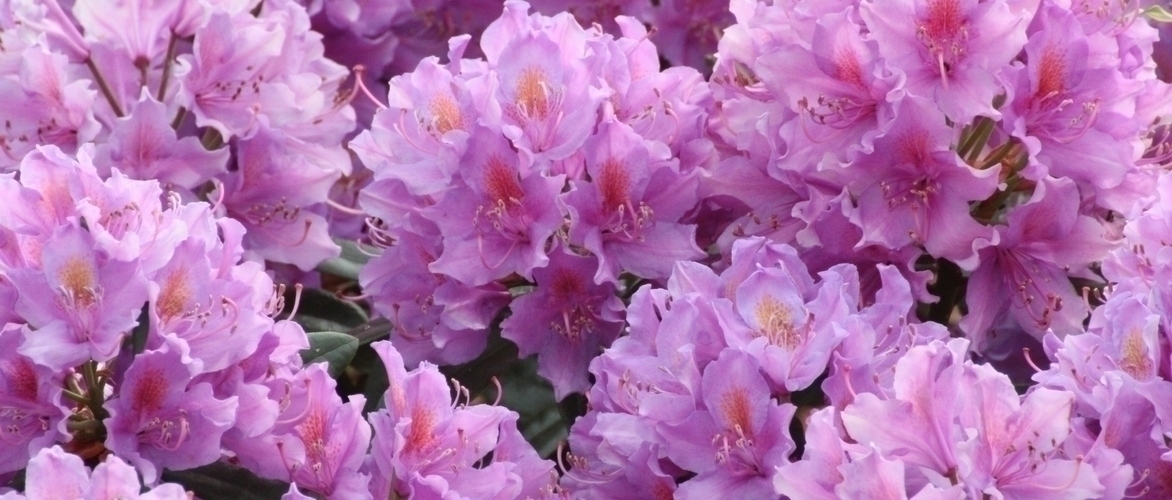
Rhododendron: planting, growing and care
Contents
Rhododendrons in a nutshell
- In May-June, they are covered in majestic flowers of various colours
- They prefer shade and acidity: they thrive in partial shade and in heather soil
- They maintain a beautiful glossy evergreen foliage all year round
- With very slow growth, they are, however, very hardy down to -25°C
- Versatile, they can be used in borders, as specimens, or in pots
A word from our expert
Rhododendrons are the stars of shady gardens: these essential ericaceous bushes ensure a very floral spring and early summer each year, with their profusion of large delicate flowers sometimes exuding a sweet fragrance. Their beautiful glossy green evergreen foliage serves as a backdrop to this exceptionally generous flowering and gives them a true presence in the garden all year round.
Devilishly versatile, Rhododendrons can be used both as solitary plants and in free hedges, as well as grouped at the edge or back of a flowerbed. They brighten up shaded corners and form multicoloured and luminous hedges ranging from pale pink to white, from crimson red to yellow or lavender, passing through all shades of pink, depending on the varieties.
Highly hardy, they thrive in light, acidic, lime-free, cool but well-drained soil where they grow sheltered from cold winds and stagnant moisture.
With a very slow growth rate but a longevity of a century, they are well-suited to small gardens or urban gardens. The modest dimensions of certain varieties such as Rhododendron yakushimanum or ‘rhodo yak’ and R. impeditum which have produced numerous dwarf hybrids, allow for use in cool rockeries or pot cultivation on a shaded terrace.
They are the perfect companions for ericaceous plants such as Azaleas, Camellias, Heathers, Hydrangeas, Andromedas… Along with other Rhododendrons from the same group, they will create spectacular kaleidoscopes of blooms in spring.
Remarkably floriferous, with their evergreen foliage, Rhododendrons are among the most beautiful ericaceous bushes. Discover our collections of large or dwarf rhododendron varieties and let yourself be seduced!
Botany and description
Botanical data
- Latin name Rhododendron
- Family Ericaceae
- Common name Rhododendron, Rhodo, Azalea
- Flowering March to July
- Height 0.70 to 5 m
- Exposure Partial shade, shade
- Soil type Heather (Acidic)
- Hardiness -25°C
Originating from deciduous forests in the mountainous regions of Europe, Asia, and North America, Rhododendrons are bushes belonging to the vast family of Ericaceae, just like heathers, Andromedas (Pieris) or Mountain Laurels (Kalmia latifolia).
The genus Rhododendron includes nearly a thousand species of evergreen, semi-evergreen, or deciduous trees and shrubs, not to mention the numerous hybridizations: nearly 9,000 cultivars that combine varieties of colours and hardiness. In botany, Rhododendrons are divided into four main groups: the evergreen large-leaved and large-flowered ones commonly referred to as Rhododendrons, deciduous or evergreen azaleas, Vireya (non-hardy tropical shrubs), and azaleodendrons, a group of very hardy semi-evergreen hybrids. Rhododendrons can also be classified by their size: large (2 to 4 m), small (0.60 to 1.20 m), dwarf (30 to 60 cm), and prostrate with slow growth and horizontal spreading that are cultivated as ground cover.
While we continue to speak of Rhododendrons and azaleas as two distinct types of plants, they actually belong to the same botanical genus. Chinese azaleas or Japanese azaleas are rhododendrons with small leaves that rarely exceed 1.5 m in height. Both bear trumpet-shaped flowers in bright and varied colours.
There are numerous varieties and hybrids of “true” Rhododendrons whose habit and sizes vary greatly.
The ornamental evergreen Rhododendrons are mostly derived from crossings between Rhododendron catawbiense, R. ponticum, and R. caucasicum. These hardy hybrids exhibit a broad and generous habit, sometimes bordering on bushy like the famous Rhododendron ‘King George’. Vigorous, some display a significant development taller than wide, with an erect and airy growth, while others are more compact. All form a dense and floriferous bush. In our latitudes, most species will not exceed 2-3 m in all directions; however, some, benefiting from the humid climate of Brittany or Normandy, can easily reach 5 to 8 m in height at maturity. Conversely, small, low, and stocky varieties belong to the group of Rhododendrons yakushimanum or ‘rhodo yak’ and R. impeditum which have produced numerous dwarf hybrids do not exceed 80 cm, forming very compact bushes perfect for borders, in rockeries, or even in pots on a terrace.
Lazy to establish, generally slow-growing, these shrubs need several years to sufficiently thicken and express their full potential. They reach their adult size after about ten years. However, they are worth the wait because, the longer the years pass, the more beautiful they become. A slowness matched only by their exceptional longevity: Rhododendrons are potential centenarians that span generations!
Spectacular and lush, the remarkable flowering gives these shrubs the appearance of fluffy clouds. In Greek, Rhododendron means “rose tree” and it is in spring that they reveal their colourful floribundity, sometimes strongly scented: a spectacle that is both visual and olfactory! The flowers come in a great diversity of shapes, sizes, and colours. In March-April, for the earliest, and early July for the latest, rhododendrons are completely covered with floral buds that open into delicate and numerous flowers, varying in size (from 2 to 15 cm wide and 2 to 10 cm long), star-shaped (Linearifolium’), tubular, trumpet-shaped (like the rare Rhododendron cinnabarinum) or bell-shaped with five lobes often marked with spots or dots that can resemble the shape of petunia flowers. Some resemble a flat cup or bear nested corollas. Sometimes, the edges of the petals are beautifully frilled (‘Horizon Monarch’). Others feature nectariferous pockets. Slightly satin, they evoke porcelain. The throat of the flowers hosts about ten beautiful stamens. Solitary or grouped at the end of numerous stems, in 10 to 20 in large round bouquets sometimes up to 30 cm in diameter (‘Lem’s Monarch’), these corollas come in an infinite palette of solid, gradient, or speckled tones ranging from white to lavender blue, through all shades of pink from pale to carmine, yellow, orange, and scarlet red. The floral buds, of a more intense hue, are adjacent to the fully opened flowers in paler shades, forming a very pretty contrast of shapes in a gradient of colours within the bush. A well-established shrub will produce bouquets of flowers in abundance on the branches. One can enjoy this staggered flowering for a good month and even more by mixing varieties.
Most Rhododendron flowers are scentless, but some hybrids (‘loderi King George’, ‘Fragrantissimum’) exude a delightful fragrance of honeysuckle or daffodil. Particularly melliferous, they attract pollinating insects.
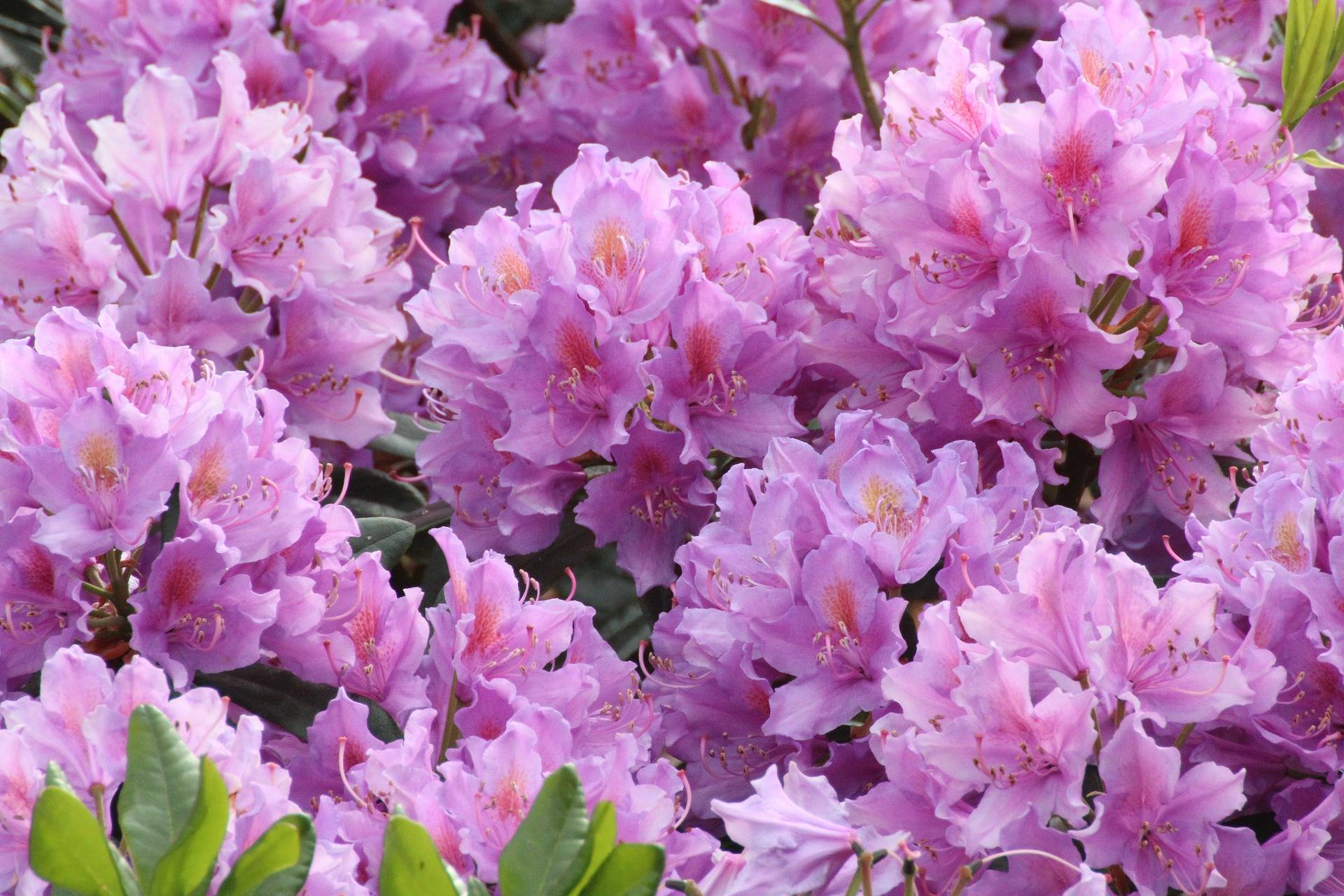
In rhododendrons, the graphic and elegant foliage remains attractive all year round, making these shrubs interesting even outside of flowering. It forms a permanent green backdrop. The evergreen leaves of a beautiful glossy emerald green are lanceolate and leathery, with a marked lighter central vein reminiscent of those of laurel. They are about ten centimetres long for dwarf species and nearly 40 cm for the largest. A distinctive foliage in the genus Rhododendron is that of R.’Linearifolium’ which bears fine and elongated leaves. Abundant and vigorous, the foliage persists for two to three years on the plant. By spreading, it adds a certain opulence to the plant. Some cultivars feature a lovely variegated foliage of yellow (‘Président Roosevelt’), while others are covered with a woolly coating or are coloured red to bronze brown or metallic blue-green.

Evergreen leaves of a beautiful glossy emerald green
Others are adorned with beautiful bark that exfoliates from pinkish brown to cinnamon and silver grey.
More demanding than capricious, “rhodos” can be quite…exclusive! They are not complicated to cultivate as long as they are planted in a soil and climate that suits them: they will then bloom for decades, without requiring much maintenance. While they can be found almost everywhere in France, including at altitude, they have a clear preference for the oceanic climate: they love coolness and high humidity and will only reveal their splendour under a cool and rainy climate.
Rhododendrons are the quintessential acidophilous plants: known as “heather plants,” they typically prefer woodland soil. If the soil does not suit them, they will decline. They have an absolute need for acidic soil (pH around 5.5), cool, but well-drained and non-calcareous. Their shallow root system makes them quite sensitive to drying out during periods of high heat. Very sensitive to excess water as well, they fear stagnant moisture in heavy and suffocating soils. Some rare varieties of Rhododendron are more tolerant of clay and limestone (Rhododendron hirsutum, ‘Inkharo’ range). All require, for good flowering, a soil rich in organic matter.
While they are demanding regarding soil type, they are relatively tolerant regarding exposure. They prefer bright exposures, but without direct sunlight during the hottest hours. We recommend planting them in non-burning sun or partial shade. Rhododendrons are perfect for gardens exposed to the north or north-east where they will benefit from morning or evening sun while being protected from excessive heat. Contrary to popular belief, they do not like too dense shadows that would limit their flowering: do not place them in competition with shrubs that could deprive them of light. In the northern regions of France, some very early hybrids even appreciate a sunny exposure. While they tolerate a light sea breeze, planting along a wall or in woodland, sheltered from cold and drying winds to preserve their foliage and early floral buds is imperative. On the other hand, they are not afraid of the cold. Perfectly hardy, they withstand temperatures down to -20 °C, sometimes more (-30 °C for Rhododendron ‘Calsap’ and R. yakushimanum), provided they are planted in a sheltered position.
Extremely versatile, Rhododendrons can be used as solitary plants, in pots, in free hedges, or in borders with perennials or other heather shrubs such as Magnolias, Pieris, Heathers, Ferns, Kalmias, Azaleas, Hydrangeas, and Japanese Maples that will continue the flowering display. With other Rhododendrons of the same group, they will form spectacular kaleidoscopes of blooms in spring. Their very slow growth and the modest dimensions of some varieties allow for use in a small hedge, in cool rockeries, at the edge of borders, and even in pot cultivation: dwarf Rhododendrons (‘Dora Amateis’‘, ‘Dream Land’) will be a lovely decorative subject all year round. With their persistent green and shiny foliage, they will play the role of a boxwood.
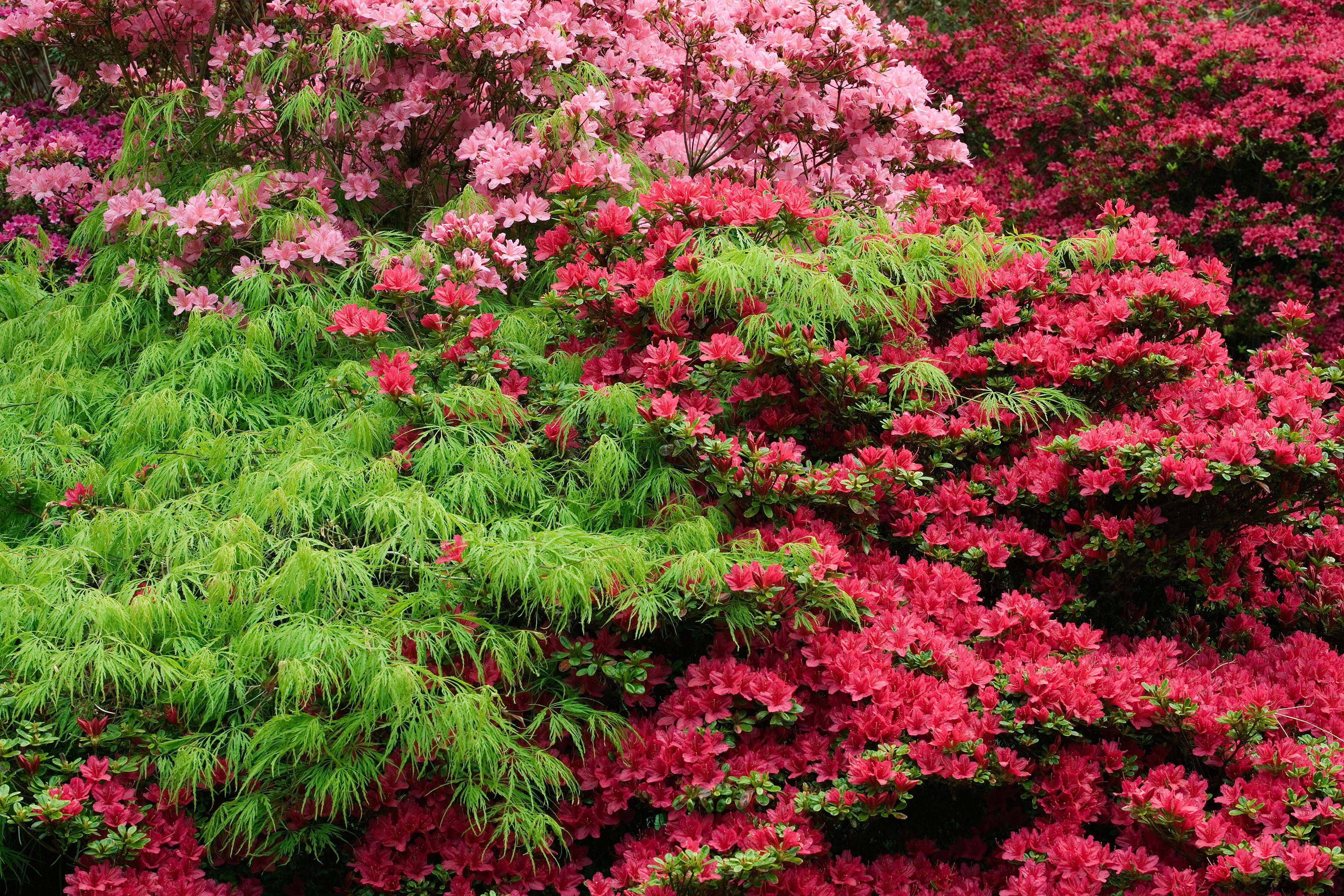 – Photo Credit GAP Dave Zubra –
– Photo Credit GAP Dave Zubra –
Read also
Which rhododendron to choose?Main species and varieties of rhododendrons
On compte de très nombreuses variétés et d’hybrides de Rhododendrons dont le port et les tailles varient beaucoup, allant des grands buissons denses de 1,50 m à 2 m de haut et d’envergure à l’âge adulte, parfaits en haies fleuries, aux petits ou “rhodos nains” de 50 à 80 cm de hauteur comme les rhododendrons yakushimanum, convenant aux rocailles fraîches, aux bordures de massifs et aux potées.
Most Popular Species
-
Among the Large “Rhodos”
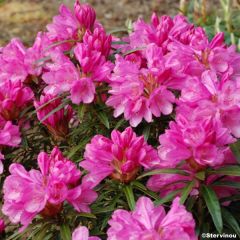
Rhododendron Graziella
- Flowering time June, July
- Height at maturity 1,50 m
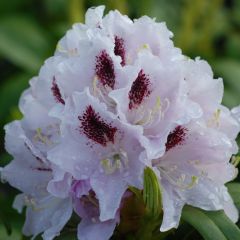
Rhododendron Calsap
- Flowering time April, May
- Height at maturity 1,30 m
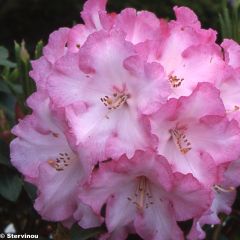
Rhododendron Lems Monarch
- Flowering time June, July
- Height at maturity 1,75 m
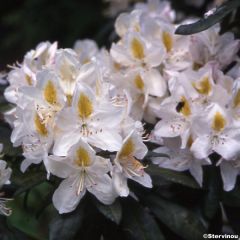
Rhododendron Madame Masson
- Flowering time May, June
- Height at maturity 1,40 m
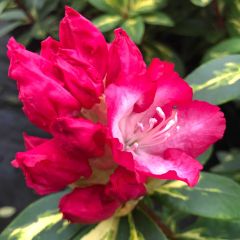
Rhododendron President Roosevelt
- Flowering time May, June
- Height at maturity 1,20 m
- Among the Small “Rhodos”
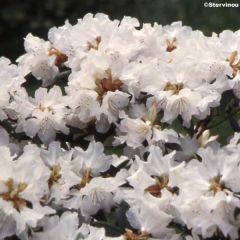
Rhododendron Dora Amateis
- Flowering time May, June
- Height at maturity 50 cm

Rhododendron Fragrantissimum
- Flowering time April, May
- Height at maturity 1 m
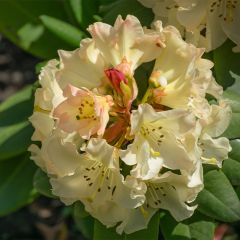
Rhododendron x yakushimanum Golden Torch
- Flowering time June
- Height at maturity 80 cm
Our Favorites
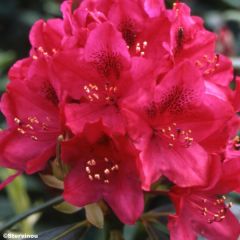
Rhododendron Nova Zembla
- Flowering time May to July
- Height at maturity 1,70 m
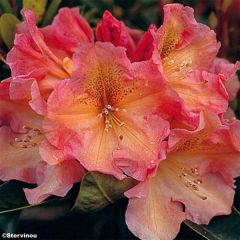
Rhododendron Olga
- Flowering time May, June
- Height at maturity 1 m
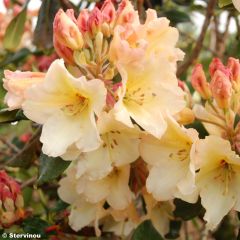
Rhododendron Horizon Monarch
- Flowering time May, June
- Height at maturity 1,80 m
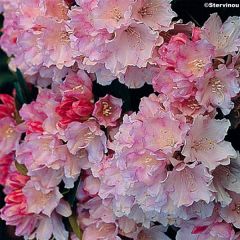
Rhododendron yakushimanum Dream Land
- Flowering time May, June
- Height at maturity 70 cm
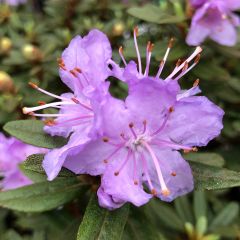
Dwarf Rhododendron - Rhododendron impeditum
- Flowering time April, May
- Height at maturity 50 cm
Other Interesting Varieties

Rhododendron Linearifolium - Dwarf Rhododendron
- Flowering time April, May
- Height at maturity 80 cm
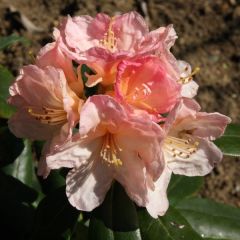
Rhododendron yakushimanum Percy Wiseman
- Flowering time May, June
- Height at maturity 1 m
To find out which rhododendron is best suited for your garden, check out our advice sheet: “Which Rhododendron to Choose?“
Discover other Rhododendron and Azalea
View all →Available in 1 sizes
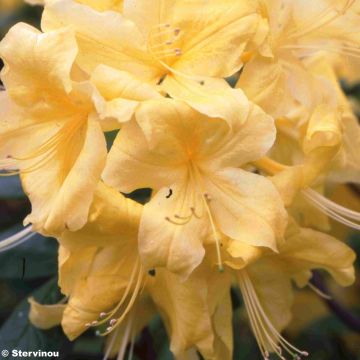
Available in 1 sizes
Available in 1 sizes
Available in 1 sizes
Available in 1 sizes
Available in 1 sizes
Available in 1 sizes
Available in 1 sizes
Available in 1 sizes
Available in 1 sizes
Young plantation
When to plant the rhododendron?
Rhododendrons can be planted all year round, but planting in spring from March to April after the frosts or in autumn from September to October, after the heat, will encourage recovery.
Where to plant rhododendrons?
- Versatile, rhododendrons fit into all settings: they can be used in borders with perennials, at the edge of woodlands, to dress a wall, in a free hedge, alongside other ericaceous plants (Magnolias, Pieris, Camellias, Heathers, Kalmias, Azaleas, Hydrangeas, Japanese Maples) that will take over the flowering during summer and autumn, as well as in isolation or in pots on a shaded terrace. Plant the tallest varieties in a sheltered wooded area, to fill a hedge, while dwarf rhododendrons (‘Dora Amateis’, ‘Dream Land’) can be placed in a cool rockery or at the edge of a border exposed to partial shade.
- With very slow growth, these compact bushes are well-suited to small gardens or urban gardens.
- They are grown in a rather shady spot, sheltered from strong winds, along a wall or under the dappled shade of large trees. Avoid too dense shade, as they need light to flower well. Ideally, they prefer north or north-west exposures.
- Plant rhododendrons that bloom before May in places sheltered from morning sun to avoid rapid thawing after an early frost that could damage the buds and young shoots.
Rhododendrons have some requirements to consider when establishing them in the garden: they need shade and acidity to thrive. They require acidic soil with a pH below 6, rich in humus, imperatively close to heather soil and not calcareous to develop.
Rhododendrons do not appreciate excess!
They also fear heavy, compact, suffocating soils and prefer cool terrains where water never stagnates: they are very sensitive to excess water, so avoid flooded areas, especially in winter. Excess water promotes contamination by Phytophthora, which can kill them as suddenly as radically. And, they dread summer drought: use ground covers like heathers to keep the soil cool during hot periods.
With very good hardiness, they are not afraid of the cold, resist frost, and can tolerate temperatures below -30 °C for some species. They tolerate marine air but fear storms and cold winds that scorch their evergreen foliage. Vigorous, they grow all over France, except perhaps in a Mediterranean climate. Their preferred climate? The cool and humid one of Brittany, where they show particular vigor! But some more versatile ones (R. Bloombux, like other varieties from the Inkharo range) break free from heather soil and the oceanic facade of our country!
How to plant a rhododendron?
Planting is the crucial step! The secret lies in the quality of the soil. If your soil is too calcareous and/or too heavy, it is better to improve it with an addition of heather soil or simply to refrain from contradicting the elitist nature of the “Rhodo”. Instead, turn to a less demanding shrub regarding soil type, or you risk having to frequently add heather soil, only to end up with a sickly and disease-prone specimen.
- Avoid calcareous soil: it will not survive. If you still wish to attempt its cultivation: replace the extracted soil with a mix of heather soil, leaf compost, and peat. Calcareous soils cause yellowing of the foliage in this shrub, known as chlorosis, which often leads to its death. You can also line the bottom and sides with a plant felt to prevent the rise of lime.
- Avoid areas where water stagnates: add gravel or pumice or a good layer of clay balls at the bottom of the hole to ensure good drainage.
- Soak the root ball for 10 to 15 minutes in a bucket filled with water before planting.
- Dig a hole three times wider than the pot and 40 to 50 cm deep: it should not be planted too deeply.
- Plant the shrub at collar level, in a mix ideally composed of 1/5 of loamy soil mixed in equal parts with peat, heather soil, leaf compost, and pumice.
- Spread an organic mulch of pine bark 8-10 cm thick or plant small perennials to protect the base and limit watering: it likes its roots to be kept cool during summer.
- Water regularly with non-calcareous water (rainwater), 2 to 3 times a week for the first 15 days after planting to keep the soil moist and cool. During the first year after planting, especially in summer and in case of drought, water abundantly.
You can opt for pot cultivation.
Choose dwarf varieties like R. ‘Dream Land’ or ‘Dora Amateis’, as their small growth is perfect for this type of use. They will thrive for many years in a large container filled with a fresh, very draining mix based on heather soil real, well-decomposed compost and good non-calcareous garden soil, kept always moist. Choose a large container of about thirty litres (30 to 40 cm in diameter) and make a bed of gravel or clay balls at the bottom. In pots, they will not tolerate even temporary drought. Rhododendrons need water all year round: close monitoring of watering, using only rainwater, will be essential. Spread a mulch or install small perennials to retain moisture.
Find even more tips on our planting sheet: “Rhododendron: succeeding in its planting”
Rhododendron care
Maintaining an established rhododendron requires a few simple yet essential actions to ensure its vitality and spectacular flowering. Here’s how to care for these magnificent bushes:
Fertilisation and soil amendment
At the end of winter, in early spring, enrich the soil by gently incorporating compost around the base of the plant, to be done annually or bi-annually. A specific fertiliser for acidophilous plants can also contribute to the substrate’s fertility, thus supporting the growth and flowering of the rhododendron.
Mulching
To protect the sensitive roots of the rhododendron and retain soil moisture, apply a thick layer of organic mulch, such as bark or pine needles, or even a carpet of leaves. This mulch, renewed each year, is crucial for keeping the soil cool during the hot summer months.
Watering
Preferably use rainwater to water your rhododendron, ensuring not to saturate the soil. During the summer season, moderate watering, two to three times a month, will suffice to maintain necessary hydration without excess.
Pruning
Pruning the rhododendron is generally not necessary. Only intervene to remove dead branches or to carry out light thinning at the end of summer, in order to preserve a harmonious habit. For aging or sparse specimens, rejuvenation pruning can be performed in March, reducing the bush to about 1 metre in height. Patience is required, as the return of flowering may take 2 to 4 years.
Also read our flower pruning tips in our tutorial How to prune a rhododendron?
Flower care
After flowering, remove faded flowers to encourage the establishment of new blooms the following year, thus ensuring abundant and prolonged flowering.
→ To deepen your knowledge on the specific care of rhododendrons, including pruning techniques, disease management, and general care, feel free to consult our comprehensive guide: “Rhododendron: pruning, diseases, and care“.
Is your rhododendron experiencing shy flowering? We explain why in: Why is my rhododendron not flowering?
Possible diseases
Cultivated under good conditions, Rhododendrons are generally not very sensitive to diseases and pests.
They can sometimes be attacked by weevils that eat the edges of the leaves and rootlets, as well as by the infamous “Rhododendron tiger,” which usually causes only minor damage.
They are primarily wary of cryptogamic diseases caused by fungi. These issues generally arise from poorly drained soil or stagnant moisture at the roots. Their main enemy: Phytophthora, a soil-borne fungus whose attack can kill them as suddenly as it is radical. The foliage discolours, browns, or reddens, then dries out. The plant then dies quickly. There is no control method, but these issues are rare if the cultivation advice is followed: plant in healthy soil, avoid excess water in the soil, and improve drainage. If, despite these precautions, an attack has occurred: uproot the affected plants and remove the soil surrounding their roots. Never replant sensitive species in the same spot.
The leaves of the Rhododendron discolour and yellow in case of excess lime (chlorosis). The culprit may simply be the watering water. Water only with rainwater.
Rhododendrons can also be affected by powdery mildew and by red spider mites, which damage the foliage.
→ Learn more about the diseases and pests of Rhododendron in our advice sheet!
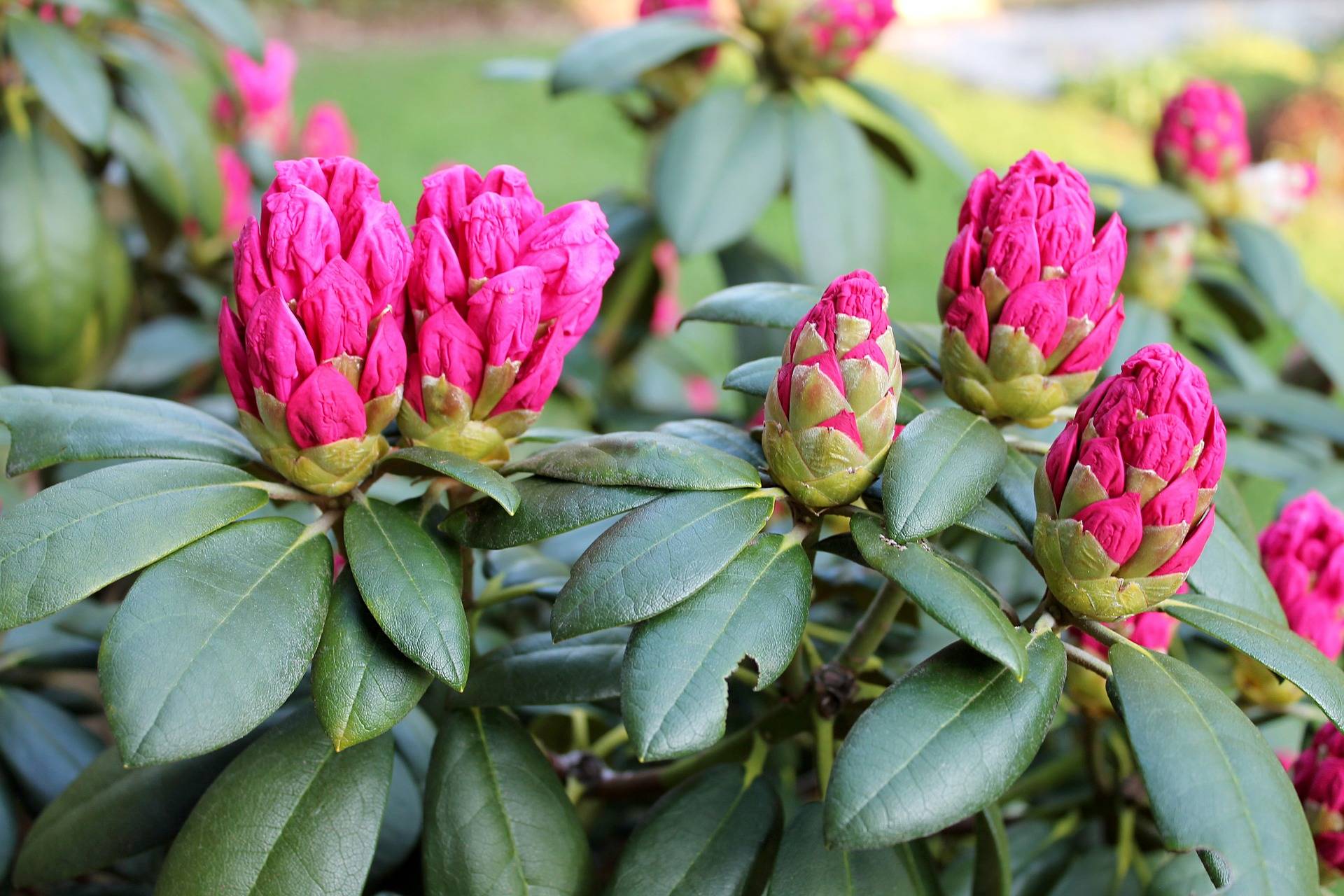
Multiplication
By layering
This is the simplest and fastest method to multiply Rhododendrons. However, one must be patient: root development is very slow.
- In October, lay a low branch down by inclining it towards the ground for about 20 cm.
- Clear the leaves from this point. Make a fine incision on the inner side of the exposed branch to remove a strip of bark.
- Dig a hole 7 to 10 cm deep, filled halfway with moist compost.
- Bury the part with the wound to encourage rooting.
- Stake the aerial part and cover it with compost.
- Water this layer generously.
- After two years, in autumn or spring, you can separate the layer from the mother plant if it has enough roots, by cutting the stem where it goes into the soil. Plant it directly for flowering the following summer.
→ Learn more in How to easily layer a rhododendron?
By semi-ripe cuttings
Easy to obtain the maximum number of new plants, but success is uncertain!
- After flowering, between July and September, take semi-woody or semi-ripe shoots of 10 to 20 cm (that is, from stems that have grown in spring and begin their transformation from softwood to hardwood from July-August).
- Remove all leaves from the lower part and make a clean cut just below a leaf node.
- Expose the bark for 2 to 3 cm in length.
- Plant them in a light, well-draining substrate. Regularly mist the cuttings with a spray bottle.
- Transfer them to buckets as soon as they have formed roots.
- Overwinter them in a frost-free environment: a constant temperature of at least 20 °C is essential for rooting in 8 to 10 weeks.
- Plant in the ground the following spring, if root development is sufficient.
→ Read also: how to easily propagate rhododendron cuttings?
How to combine rhododendrons in the garden?
Very versatile, Rhododendrons can be used both in free hedges with other heather soil bushes, and in borders with perennials, as solitary plants, and even in pots: plant the tall varieties in a sheltered location to create a free hedge or dress a wall. They will be the ideal companions for other acidophilous plants such as Magnolias, Pieris, Heathers, Ferns, Kalmias, Azaleas, Hydrangeas, Japanese Maples, Camellias, or Hostas that will continue the display of flowering. With other Rhododendrons from the same group, they will form spectacular kaleidoscopes of spreading blooms. Their very slow growth and the modest size of some varieties allow for use in a small hedge, in cool rockeries, at the edge of borders, and even in pot culture: dwarf Rhododendrons (‘Dora Amateis’, ‘Dream Land’) will be a lovely decorative feature all year round. With their evergreen, glossy green foliage, they will play the role of a boxwood.
Need more inspiration? Visit our association sheet: “Rhododendron: 9 ideas for successful associations”
Useful resources
- Discover rhododendrons at the National Botanical Conservatory of Brest
- Advice sheet: Rhododendrons: the best varieties
- Advice sheet: Dwarf rhododendrons and azaleas: the best varieties; 7 dwarf rhododendrons for small gardens and pots
- Plant sheet: Azaleas: planting, growing, pruning and maintenance
- Advice sheet: Rhododendrons: how to grow them in pots
- Advice sheet: Rhododendron: 9 successful pairing ideas
- Advice sheet: Rhododendron: pruning, diseases and maintenance
- Advice sheet: Which rhododendron to choose?
- Advice sheet: Rhododendron: succeeding in its planting
Frequently asked questions
-
Is it concerning that my rhododendron, which has been in the ground for two years, is not shooting?
It's normal. Slow-growing, the rhododendron is very lazy to establish: its roots develop very slowly in the soil. It will take many years to see it form a proper bush. Patience is rewarded by its flowering, which is truly unique!
-
Should I prune my rhododendron?
It is unnecessary. Only intervene to remove any dead branches or to carry out, at the end of summer, a very light refresh above an eye to maintain a balanced habit. Old neglected bushes or those too bare at the base can be cut back in March, using a saw, to about 1 metre above the soil. After this severe pruning, it will take 2 to 4 years to see it flower again.
-
My rhododendron is losing its leaves which are turning yellow. Why?
Rhododendron enjoys being fed annually on the surface with decomposed compost and leaf mould, as the soil may be too poor for it. Intolerant to lime, its leaves discolour and turn yellow in case of excess lime (chlorosis). Lime-rich watering can also be responsible. Water only with rainwater.
-
Can I still plant a rhododendron in slightly chalky soil?
Yes, but it's not a done deal! The leaves of the rhododendron discolour and turn yellow in the presence of excess lime (chlorosis). If your soil is too alkaline, consider either Inkarho rhododendrons or a less demanding bush regarding soil type, otherwise you may have to frequently add heather soil, resulting in a sickly plant that is prone to diseases. If you still wish to attempt its cultivation, prepare the soil with a substrate composed of equal parts heather soil or turf, potting compost, and my topsoil, lining the bottom and sides of the hole with a plant felt to prevent the rise of lime.
-
What should I do if the leaves of my rhododendron have brown spots and are falling off abnormally?
This is very common with rhododendrons. These brown spots are caused by what is known as the "rhododendron tiger", a small insect that devours the leaves and rarely causes serious damage. To limit the infestation: spray a solution based on clay or black soap.
- Subscribe!
- Contents































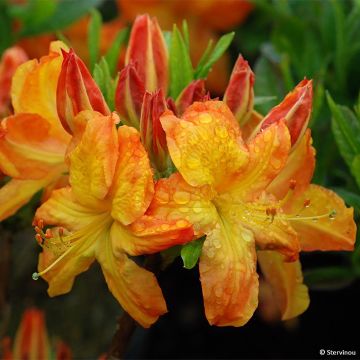
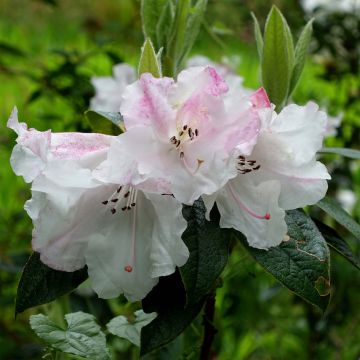
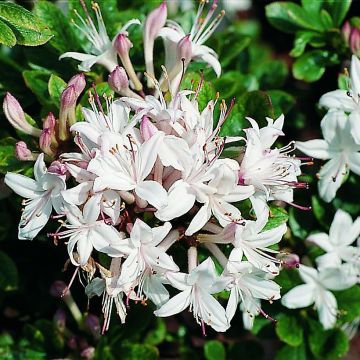
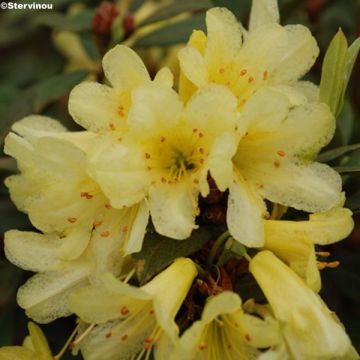
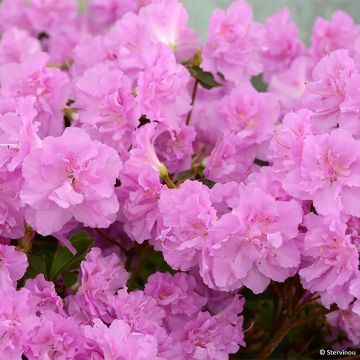
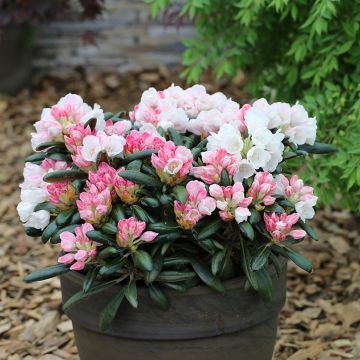
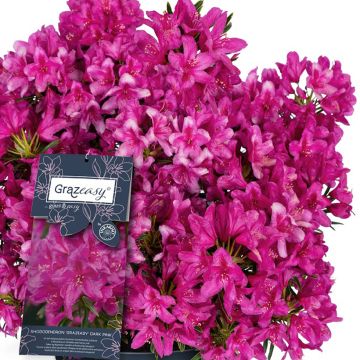

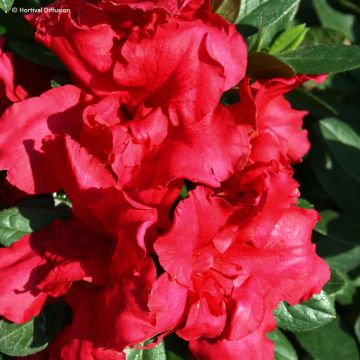
Comments